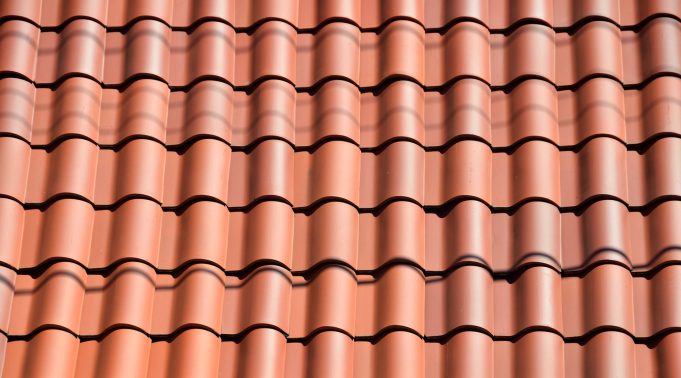Clay roofs appear to have been existing for a long time. China has discovered 12,000-year-old tiles. They can be found in a lot of ancient Greek and Roman architecture, as well as in a lot of different construction styles all across the world and through the years. Clay tile roofs may be exceptionally long-lasting and low-maintenance under the correct conditions, but clay tile is not suitable for every region.
Clay is a natural resource that is mined where it is abundant, shaped into a variety of tile forms, and burnt in high-temperature kilns. Clay roofing must be installed appropriately to ensure protection from water, to help with its durability. The terra cotta red hue comes from the iron element in the clay. The burnt clay is buff to brown in the absence of iron. Before burning, the clay tiles are sometimes rinsed with manganese solution to generate deeper variations of the basic hue. Glazed tiles may be painted in any colour. You’ll learn everything you need to know about clay roofs and check out this article for more info about TPO roofs koalaroofingco.com.
Clay Roofs: Important part of roofing system
While old roofs depend on clay tiles to keep rain out, current construction codes are less forgiving. Although clay roof scatters water, it cannot totally prevent wind-driven rain penetration. A modern clay roof need a solid wood or plywood composition board flooring with adequate nail-holding qualities. One or more layers of No. 30 asphalt-saturated felt paper or self-adhesive waterproofing membrane to work adequately.
After all, the durability of your roof is only as good as its weakest component. The weakest link in a clay tile roof would be aluminium or galvanized sheet metal, which would be sufficient for the life of an average asphalt roof. Flashing for clay tile, on the other hand, must be made of heavy-gauge copper or stainless steel. Similarly, the nails used to secure clay tiles to decking should be made of corrosion-resistant copper or stainless steel. In windy places, the tiles must additionally be fastened at the front using copper or stainless steel nose clips to avoid lifting or rattling.
Clay Roofs Are Best Left to the Professionals
Constructing and installing a clay roof is a job for trained professionals; every component, from the aforementioned underlayment and flashing to the appropriate installation of the roof, is vital and demanding. Even the tiles that make up the main body of the roof, known as the field, have very precise criteria, some of which may change depending on the slope of the roof and the expected extremes of local weather. Individual tile fasteners must not be over-driven or the tile may fracture. Fitting the tiles to the roof surface on roofs with various and complicated angles, or on a curved roof, necessitates a large quantity of custom cutting to angle or taper the tiles. Needless to say, this is time intensive and adds greatly to the expense of a roof that is already costly.
Clay tile roofing is a Weighty Choice
A clay tile roof, like concrete tile, is an extremely heavy roofing material, weighing more than three times as much as an equivalent asphalt composite shingle roof. That implies your roof supports’ construction must be strong enough to sustain all of that increased weight. New building can be designed to those structural standards, and a roof that previously bore a tile roof can be assumed to be capable of supporting another. A roof that was not designed expressly for tile, on the other hand, must be inspected and approved by a structural engineer, and strengthened if necessary. If these “hidden” costs apply, they must be included into the total cost of a clay tile roof.
Benefits of Clay Roofs
Are clay roofs good?
Clay roof tiles are one of the most durable roofing materials available. Installation and maintenance expenses are significantly lower than other materials in the long term due to their lengthy lifespan.
Clay tile promoters may claim that it may endure 75 to 100 years as a roofing material, and it can undoubtedly do so under the correct conditions. The tiles may very well outlast your house and survive to be recycled to another roof if they are not damaged by walking on them, fallen tree branches, or the freeze/thaw cycle of northern climes. They can be squashed and brought back to the earth with no environmental impact if they are not reused.
The tile-supporting battens and water-repellent underlayment are expected to last 40 years or fewer. If leaks or loose tiles are caused by degradation of the underlying support, the entire roof may have to be removed while the underlayment and battens are replaced. Imagine the pain of recording each tile and its appropriate place if the roof array contains numerous cut and fitted tiles. The water-repellent underlayment and tile-supporting battens have an estimated lifespan of 40 years or less
Costs of a Clay Roof
In the long term, they’re cost-effective. Clay tile roofs cost between $15 and $30 per square foot to install, according to most surveys. When compared to ordinary asphalt shingles, which may cost anywhere from $3 to $8 per square foot to install, this is a bargain. When replacing a tile roof on a structure that already has one, expect to pay around the low end of this range for installation; if structural strengthening is required, expect to pay near the high end of this range, and perhaps much more if extensive work is required. Before the roofing work begins, it’s not uncommon for the structural repair to cost $10,000 or more. However, the high cost is offset by the fact that slate has a longer lifespan than any other roofing material.
Conclusion
A clay tile roof is a worthwhile long-term investment since it is long-lasting, fireproof, resistant to severe wind damage, a thermal barrier that may buffer against temperature extremes, and, above all, it is an inextricably lovely crown to the architectural forms that demand for it. It may even turn out to be cost-effective if the installer’s work is exceptional and the weather is pleasant.














